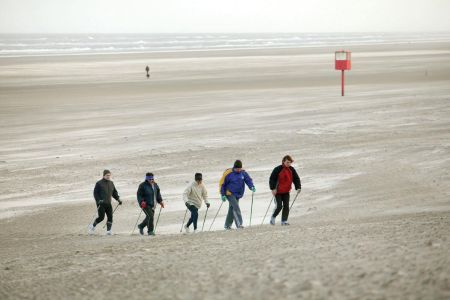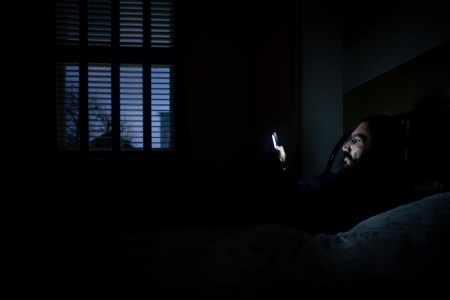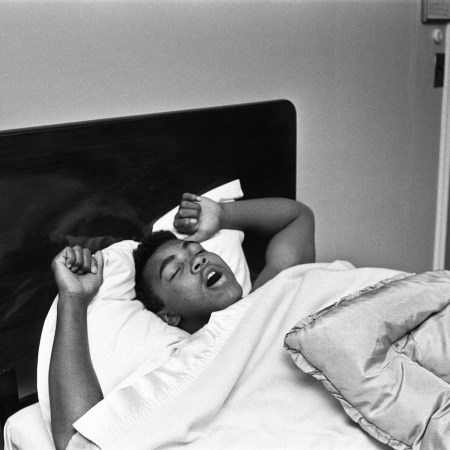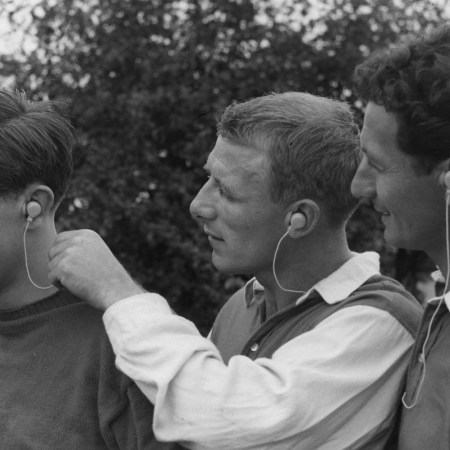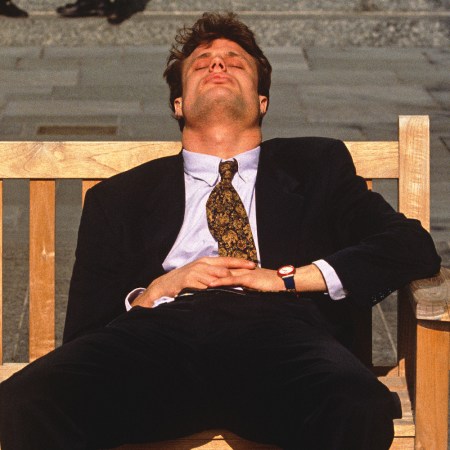The sun’s soon going to be setting at around 4:30 in the afternoon. For some of us — like one of my colleagues, who waits all year to put on a fisherman’s sweater and sit in the darkest booth of a pub — this is cause for celebration. Shorter days are a time to hunker down and hamper expectations. These months represent an opportunity to cook more, light candles and fall asleep next to a fireplace with a book on one’s lap. You know: cozy shit.
But “lane-shifting” seasonal habits doesn’t come easily to everyone. In fact, an estimated 10 million Americans suffer from seasonal affective disorder, a season-specific modulation of major depressive disorder, which generally starts in late fall and doesn’t ease up until the sun returns for good in mid-spring. In recent years, the disorder has become a zeitgeist-y term, likely because of its on-point acronym (SAD) and the frequency and casualness with which X users and TV shows allude to it.
That isn’t a bad thing, necessarily. It’s important people are aware of the disorder’s prevalence and the harm it can cause (from insomnia, to weight fluctuations, to feelings of intense isolation). But those who suffer from SAD should also be aware that the hopelessness it causes isn’t inevitable. Beyond talk therapy and and medication — either of which might be prescribed after an accurate SAD diagnosis — there are lifestyle changes that you can incorporate into your day to get ahead of the disorder.
SAD Isn’t Inevitable
According to licensed psychologist Dr. Marcuetta Sims, “Far too often people wait until they’re in the thick of it to start doing something about it. But it really helps to have those necessities in place.” That’s the one benefit (if you can call it that) of seasonal depression: you know it’s coming. Seasonal affective disorder generally starts between the ages of 18 and 30; while it catches 20-somethings off guard at first, two straight years of seasonal symptoms mean you’ve got it.
Why does it happen at all? Well, darker days can really mess with our heads. The sudden and dramatic decrease in sunlight exposure disrupts sleep-wake cycles and suppresses mood-regulating hormones like melatonin and serotonin. It affects our decision-making, appetite and motivation — three pretty important things to have compromised for 40% of the year. Check out this map for where the disorder is most common. While only 5% of the total American population is dealing with SAD, that varies by latitude. New York, for instance, is closer to 17%. Fairbanks, Alaska, stands at 30%.
Even if you don’t suffer from seasonal affective disorder, you’ve likely struggled with your mood and relationships during the winter. A mild case of wintry funk is perfectly natural. Plus, the medical community is continuing to learn that certain conditions operate on a spectrum. In this case, preparing for the year’s chilliest months as if you have SAD can really only help you have a happier, healthier fall and winter. From earlier wake-ups to cold-weather sunbathing to eating more carrots, here are some fortifying micro-habits that will see you through the tough seasons ahead.
How Many Minutes Per Day Should You Spend Outside During Winter?
Plus, lessons from a Norwegian town well north of the Arctic CircleWill Yourself to an Earlier Wake-Up
This is the most common answer you’ll see from psychotherapists, trainers and other lifestyle experts. Consider this: on the same day that the sun’s setting at 4:30 p.m., a month from now, it’s rising right around 7:00 a.m. With fewer than 10 hours of sunlight to take advantage of — and almost all of them spent at work — it’s imperative that you put yourself in a position to succeed by adjusting your wake-up time.
That’s not going to be easy, especially if you’re a “night owl” (which is genetically ingrained into certain people, according to recent research), and the WFH era has only made it harder (without commutes, it’s easier to sleep in and work from bed), but it can be done. As the American Academy of Sleep Medicine’s Dr. Nitun Verma tells us, “Think in terms of a week or two” for that change to sink in. And do your damnedest to stick to it: “People usually sleep better if they tend to wake and sleep at similar times each day.”
Light Boxes and Dawn Simulators
A light box is a specially designed device that spits out light similar to daylight (5,000–6,000 kelvins, usually at 10,000-lux) for “sessions” of 30 minutes at a time. It’s not the silver bullet that Bed Bath & Beyond would have you believe, but it is effective. Numerous studies have confirmed that sitting next to these things as early as possible each day can have a positive impact on SAD. As Harvard Health points out: “[Light boxes are] about 100 times brighter than usual indoor lighting; a bright sunny day is 50,000 lux or more.” On gray days, sitting with your morning coffee in front of a light box might be your best shot at getting the light you need.
That said, some caveats: only buy one after consulting with your doctor, buy whatever your doctor recommends (they aren’t regulated by the FDA and there is some true crap out there), don’t ever look directly at the light and if you forget to use it, don’t compensate by firing it up in the afternoon. That could ruin your sleep. If a light box sounds like too much hassle, look into getting a dawn simulator, which is basically an elegant “sunrise alarm clock.” We’re fans of the Restore by Hatch.
Take a Hint from Scandinavia
Seasonal affective disorder can’t be waved away with a couple magic words. T.L. Robinson, an expert in trauma and depression (particularly from the perspective of survivors), stresses the importance of calling out “toxic positivity.” She says: “Nonsense like ‘good vibes only’ or ‘push through it’ or ‘it’s all in your mind’ are very dangerous.” So if you’re going to turn to a catchphrase, make sure there’s a cogent philosophy attached to it.
For dealing with seasonal depression, no region has a better game-plan than subarctic Scandinavia. The Nordic Nations have exported a grab-bag of globally famous terms over the last few years, from hygge (embracing coziness — think blankets, aromatherapy, dinner parties) to koselig (celebrating the outdoors, especially in winter) to kalsarikänni (getting plastered in your underwear). One fascinating sociological study from last year indicated that far-flung towns in Norway are actually better at beating winter than anywhere else in the world. That’s namely because the locals who brave the polar night each year don’t actually see winter as something to “beat.” Knowing the season will arrive each year no matter their mindset, they embrace it. Hence the candles, snowshoeing and boxer-brief beers.
Why Do I Wake Up 10 Minutes After Falling Asleep?
It’s a phenomenon called “hypnic jerk.” Here’s what to know.Supplements Aren’t the Answer
Specifically Vitamin D supplements. Dr. Sims dubs these one of the more “overrated” SAD solutions out there. “You don’t necessarily have to avoid [them], as it probably won’t hurt to have more vitamin D, but there isn’t scientific evidence that suggests that taking Vitamin D supplements actually help with SAD.”
That shouldn’t discourage you from taking Vitamin D supplements in general; if you have a deficiency (and most of us do, go get your bloodwork done), it’s a good idea. But know that it can’t cure seasonal depression on its own. In fact, as of yet, there isn’t an OTC supplement, pill, capsule or gummy that’s going to cure the way the winter makes you feel. Be wary of brands — like this one, which sells a $30-per-pouch mycolicibacterium-based daily psychobiotic — that want to convince you otherwise.
Don’t Give Up on Fitness Goals
You work too hard the rest of the year to take five months off just because the days are shorter. Jody Braverman, a certified personal trainer who suffers from SAD each year, stresses the importance of keeping your fitness routine firing throughout the winter. She recommends “switching workouts to the morning or to midday.” It’s your best shot to actually catch some sun, it’ll put you in the right mood to move your body and in the WFH era, it’s actually possible.
“Noon to 2 p.m. is a great time to get outdoors for some activity— run, jog, bike, hike,” she says. “Unfortunately, people with SAD feel more fatigued and unmotivated during the winter months and are more likely not to keep up with their fitness routine. But that’s counterproductive and will just make SAD worse.” Braverman suggests setting fall/winter fitness goals now (the same way you like to set them for beach season) and giving yourself something to stick to through March. If you’re determined to exercise inside — at the gym or on the Peloton — consider plugging a morning constitutional into the day. The days may get shorter, but the workdays remain long; a morning walk will give you the leg up you need.
Wintry “Sunbathing”
Not the usual kind — you’re not going out there with tanning oil. This brand of sunbathing involves recognizing the once-in-a-while wins that late fall and winter provide. It’s as simple as sitting on a bench in a park (maybe with lunch) and letting a few rays wash over you, no matter how feeble they may be. The best part about this sort of ritual is it engages with most other things on this list; it encourages getting outside, getting exercise and getting some Vitamin D. Plus, it’s a natural mood-booster.
Sun-exposure increases serotonin production, which acts as a corrective for hormonal imbalances at this time of year. Aim to chase the sun at sunset or sunrise (so, likely 7 a.m. or 5 p.m.), at which point the sun will be at its lowest points and easier to “bathe” in. Oh, and while it might feel insane, get some sunscreen on your face. Dermatologists recommend wearing it year-round, especially when snow is on the ground, which reflects UV rays into the skin the same way that water does.
Feeling Uninspired? It’s Time to Assign Yourself a Syllabus.
Pick a subject. Then line up a novel, podcast, film and trip to a museum.How to Eat This Winter
Here’s a good rule of thumb: heart-healthy foods are always going to help, no matter the mental or physical malady. So at a time when we’re particularly drawn to fried and starchy foods — winter weight is a verifiable scientific thing — doubling down on a diet fueled by whole foods and local ingredients is an excellent idea. Prioritize brain-happy foods like fish, beans, leafy greens and fruits.
If you need a sweet, pick up dark chocolate with high cocoa content — more than 80% is best. And try to make the first meal of the day your biggest and the final meal your smallest (“Eat like a prince in the morning and a pauper in the evening”). Closing the kitchen nice and early will help your body lean into a wind-down process that’s actually in line with the end of the day. If you need to put a number on it, nutritionists and sleep experts seem to agree that having a “three hours before bed” cutoff is your best bet.
Avoid the Urge to Cocoon
It’s easy to sequester yourself when the world is pitch-black for the last two hours of your workday. Next time you’re looking to order Thai and binge a show, though, think about a quote featured in our longevity guide: “Social connections are probably the single-most important feature of living a long, healthy, happy life.” You don’t have to have plans every night of the week. But you should keep yourself in the game. Join a league, see some live music, make plans to catch up with an old friend. The old-school stuff that helps people with major depressive disorders is going to help people with a seasonal disorder, too.
Meanwhile, if you’re still unsure that any of this will do the trick, make sure you’re seeing a therapist. Dr. Sims proposes handling that ASAP. “Go ahead and get on a/your therapist’s calendar if you haven’t already been meeting with one,” she says. “This time of year is a difficult time for many reasons. But don’t beat yourself up. Offer yourself tons of compassion and take good care of yourself. ”
The Charge will help you move better, think clearer and stay in the game longer. Subscribe to our wellness newsletter today.

